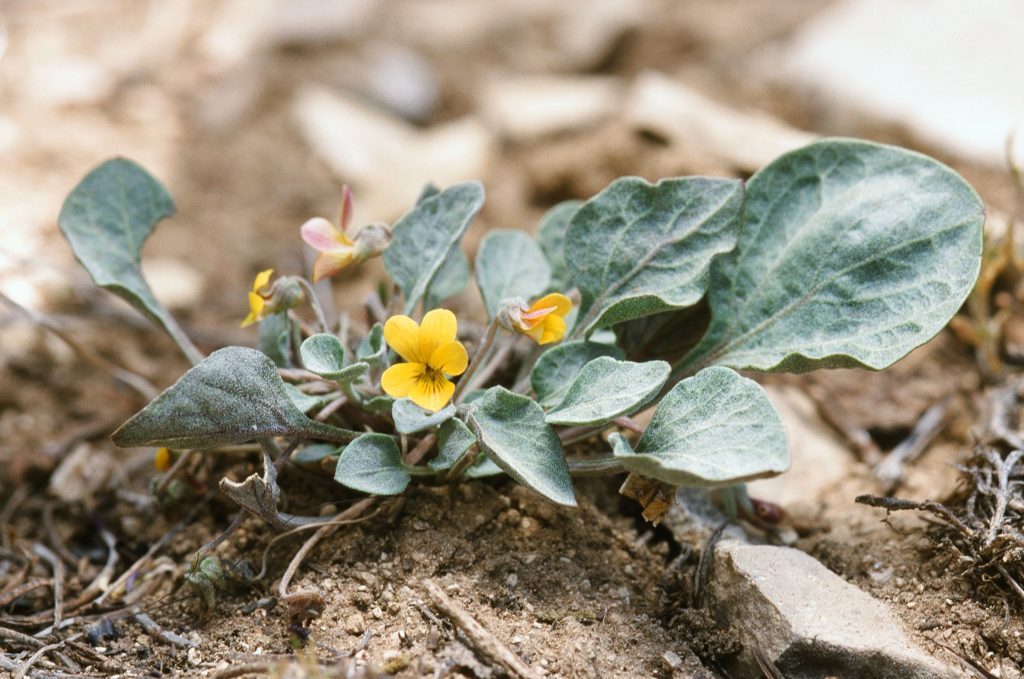Viola charlestonensis
Kim’s unfinished notes. Illustrations: 2 photographs of Viola charlestonensis and 2 drawings.
Clockey, Madroño 8: 58. 1945.
I.W. Clockey was a plant collector. Type collected in the Nevada area, 23 May, 1937.
Diploid species, 2n=2x=12, where x is the base chromosome number for section Chamaemelanium.
- SW Utah and Clarke County, Nevada
- glaucous thick leaves, purple-tinged beneath
- golden yellow flowers
- short stems partly underground
- entire leaf margins, ocassionally with a few small teeth
- limestone substrate
- spur and upper two petals puberulent on the outside
- pubescence on foliage backward pointing , short and adpressed
- pedunces unusally curved for the whole length.

A threatened species, the Charleston Mountain violet is the only species having a puberulent spur, with the puberulence often extending along the lower petal mirib and sometimes onto the back of all petals. Glaucous herbs, arising from short vertical root-stock, stems largely below ground.

Basal and cauline leaves. Petioles to 3 cm long; leaves broadly ovate to suborbicular, truncate to cuneate at base, obtuse and often mucronate apically; 1.2- 3.0 cm wide; basal stipules adnate to the base of the petiole with lanceolate, membranous free lobes, the cauline stipules free. Persistent basal peduncles with attached dried stipules form a sheath around the growing central stems, as occurs for Chamaemelanium, subsection Crysanthes.
Peduncles borne from cauline axils but curve downwards with pos resting near the ground until maurity, when they turn upwrds before dehiscing. Peduncle 2-9 cm long, bracteoles about midlength, narrowly lanceolate. Flower petals golden, the upper usually brownish or purple-tinged and often puberulent dorsally, the lower 3 with brownish-purple guidelines, puberulent on the outside (sometimes glabrous in Utah populations), the lateral pair with clavate beard within, the spur short, puberulent, 0.4-1 mm long, blunt; style head with rerorse hairs on back, ovary pubescent. Sepals 3-5.3 mm long, lanceolate, scarcely auriculate basally, acute apically.
Seed capsule trigonous, two to three large seeds per locule 6-8 mm long, puberulent, seeds shiny dark brown to black, about 3.5 x 2.1 mm long including elaiosome.

Habitat: Growing on limestone only, moderately mesic sites, in full sun. V. charlestonensis is host to Carol’s Fritillary Butterfly (Speyeria carolae) which lays its eggs singly on litter near the violet plants. First stage caterpillars over-winter unfed and in the spring feed on the violet leaves.
Range: Southern Utah and southern Nevada (Clark Co., Lee Canyon). Mt. Charleston, west of Las Vegas in southern Nevada; Washington and Kane Counties, southwestern Utah, 1981-2896 m. associated with Cercocarpus, Juniperus and an occasional Pinus ponderosa, P. scopulorum and P. monophylla. Also collected Charleston Park, Clark County, Nevada, in the range directly west of Las Vegas; in Coconino Co., Arizona., on the Kolob Plateau.
Nomenclature & Taxonomy
Section Chamaemelanium Ging., subsection Nuttallianae (Marcussen, 2011).
Viola charlestonensis M.S. Baker & J.C. Clausen
Clockey, Madroño 8: 58. 1945.
I.W. Clockey was a plant collector. Type collected in the Nevada area, 23 May, 1937.
Diploid species, 2n=2x=12, where x is the base chromosome number for section Chamaemelanium.
